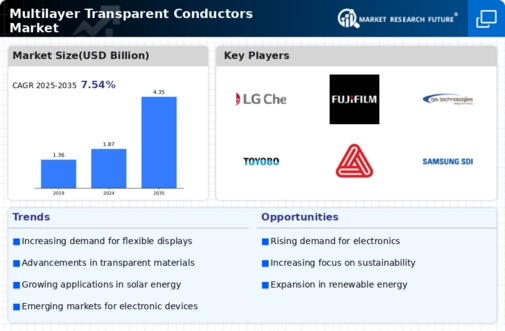Top Industry Leaders in the Multilayer Transparent Conductors Market

The Competitive Landscape of the Multilayer Transparent Conductor (MLTC) Market
The multilayer transparent conductor (MLTC) market is illuminating the future of various industries with its exquisite blend of electrical conductivity and optical clarity. From touchscreens and OLED displays to solar cells and smart windows, MLTCs are transforming the way we interact with technology and harness light. Navigating this dynamic market requires a clear understanding of the competitive landscape, the strategies of key players, and the factors shaping its trajectory.
Key Player:
- Fujifilm Holdings Corporation
- 3M Company
- Dontech Inc.
- Eastman Kodak
- Nitto Denko Corporation
- Thin Film Devices Inc.
- Eastman Kodak
- Canatu OY
- DuPont Teijin Films
- Abrisa Technologies
- Toyobo Co., Ltd.
Strategies Adopted by Leaders:
- Technology Prowess: Infineon Technologies and Broadcom Inc. lead the charge with high-performance, miniaturized MLTCs and sophisticated software for control and monitoring, setting the benchmark for efficiency and reliability.
- Vertical Specialization: SensiTech focuses on environmental monitoring applications with sensor solutions for gas detection and pollution control, while Murata Manufacturing caters to the automotive industry with MLTCs for touchscreens and head-up displays.
- Partnership Play: Texas Instruments collaborates with universities and research institutions to develop novel materials and fabrication techniques, fostering co-development and staying ahead of the curve.
- Cost Competitiveness: Microchip Technology prioritizes affordability and offers entry-level MLTC solutions, catering to price-sensitive segments, particularly in emerging markets.
- Open-Source Platforms: Silicon Labs promotes open-source software tools for developing MLTC applications, empowering developers and accelerating innovation in the ecosystem.
Factors for Market Share Analysis:
- Technological Leadership: Companies offering superior transparency, conductivity, and durability command premium prices and secure market share by enabling precise detection, efficient power transmission, and long-lasting performance.
- Application Specificity: Tailoring MLTCs to the specific needs of different applications, like high-precision touchscreens or flexible displays, is crucial for market penetration.
- Form Factor and Size: Miniaturization and ability to integrate MLTCs into small devices without compromising performance are essential for diverse applications.
- Scalability and Manufacturing Efficiency: Cost-effective production processes and scalability for large-scale manufacturing are crucial for wider adoption and affordability.
- Environmental and Sustainability Focus: Developing eco-friendly materials and adhering to sustainability standards in production aligns with the growing focus on green technology and responsible manufacturing.
New and Emerging Companies:
- Startups like SensiQ Technologies and Chirp Microsystems: These innovators focus on niche applications like gesture recognition and medical diagnostics, pushing the boundaries of sensor capabilities and unlocking new potential for MLTCs.
- Academia and Research Labs: MIT's Microsystems Technology Laboratories and Stanford University's Sensor Actuator Center explore novel materials, deposition techniques, and device architectures, shaping the future of MLTC technology.
- Material Science Players: Companies like Corning and Kyocera develop advanced materials for electrodes and transparent insulators, influencing core technologies and performance in the market.
Industry Developments:
Fujifilm Holdings Corporation:
- November 2023, Fujifilm announced a breakthrough in developing a new transparent conductive film with high transmittance and low haze, aiming to improve the brightness and clarity of displays.
3M Company:
- September 2023, 3M launched a new line of conductive inks for flexible printed electronics applications, including wearable devices and touch sensors.
Dontech Inc.:
- October 2023, Dontech partnered with a university to research and develop novel transparent conductive materials using nanotechnology.
